Analyzing Whitegoods Company: An Organizational Behavior Case Study
VerifiedAdded on 2023/04/24
|8
|1600
|129
Case Study
AI Summary
This case study examines the organizational behavior issues within Whitegoods Company, focusing on the experiences of Sylvia Harrison and the company's detrimental work environment. Key problems identified include a lack of work-life balance, limited career advancement opportunities due to an age-based promotion system, a deficient organizational culture, and an authoritative leadership style. The analysis applies relevant managerial and organizational behavior theories such as the Goal Setting Theory, Hierarchy of Needs Theory, and Traits Theory to propose strategies for improvement. These strategies include implementing a career advancement plan, involving employees in management decisions, and enhancing the overall work environment. A strategic implementation plan, centered on employee engagement, is presented with actionable steps, responsible parties, and associated costs. Desklib provides students access to similar solved assignments and resources.
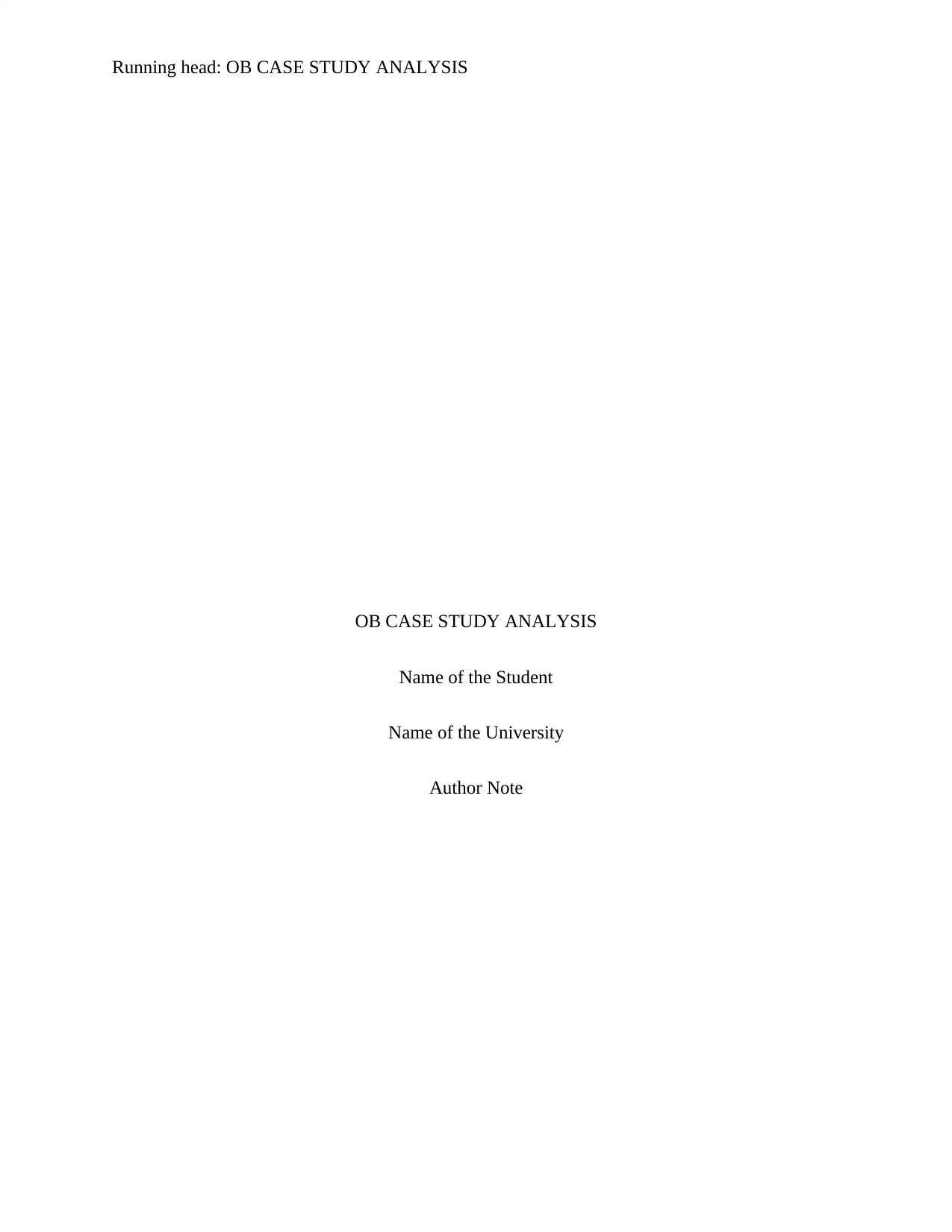
Running head: OB CASE STUDY ANALYSIS
OB CASE STUDY ANALYSIS
Name of the Student
Name of the University
Author Note
OB CASE STUDY ANALYSIS
Name of the Student
Name of the University
Author Note
Paraphrase This Document
Need a fresh take? Get an instant paraphrase of this document with our AI Paraphraser
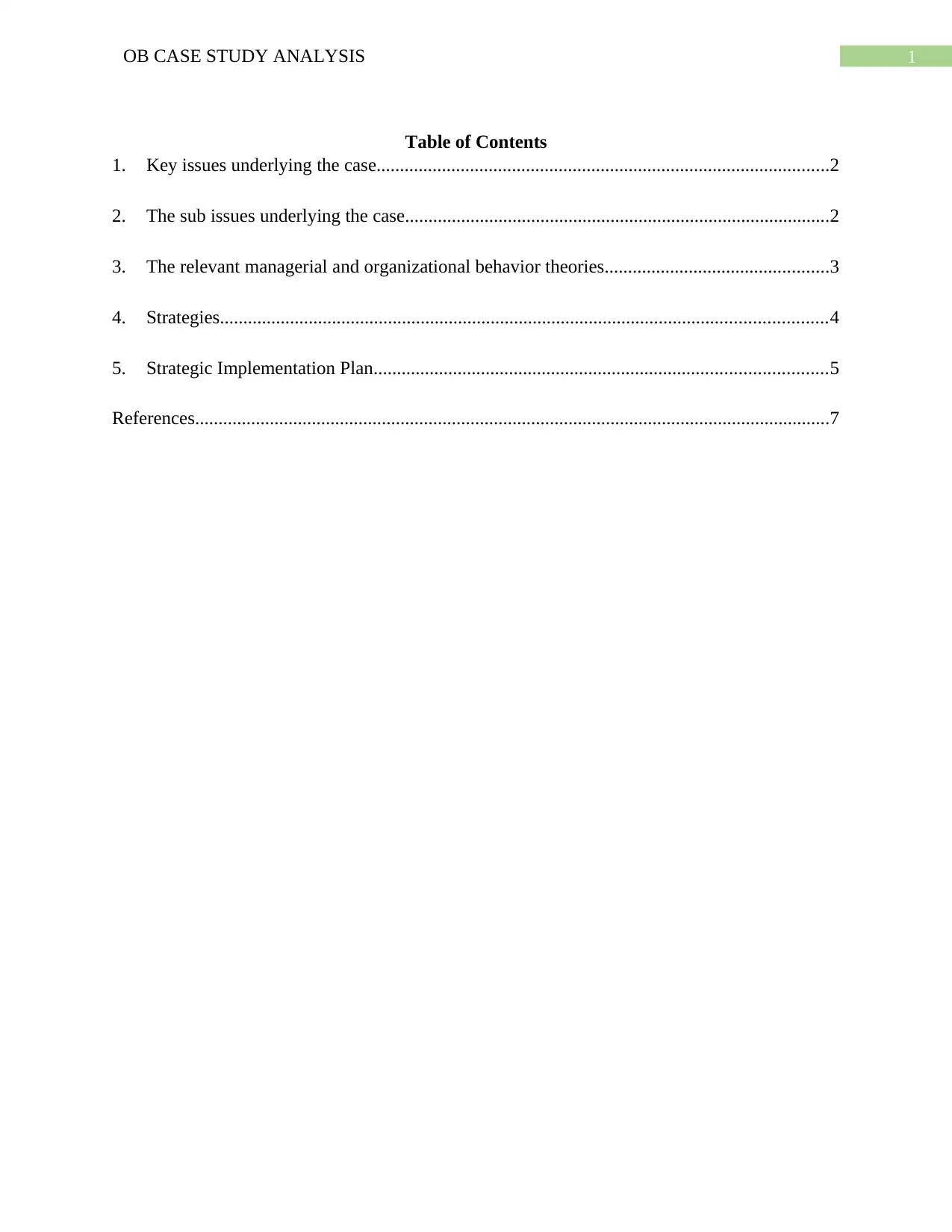
1OB CASE STUDY ANALYSIS
Table of Contents
1. Key issues underlying the case.................................................................................................2
2. The sub issues underlying the case...........................................................................................2
3. The relevant managerial and organizational behavior theories................................................3
4. Strategies..................................................................................................................................4
5. Strategic Implementation Plan.................................................................................................5
References........................................................................................................................................7
Table of Contents
1. Key issues underlying the case.................................................................................................2
2. The sub issues underlying the case...........................................................................................2
3. The relevant managerial and organizational behavior theories................................................3
4. Strategies..................................................................................................................................4
5. Strategic Implementation Plan.................................................................................................5
References........................................................................................................................................7
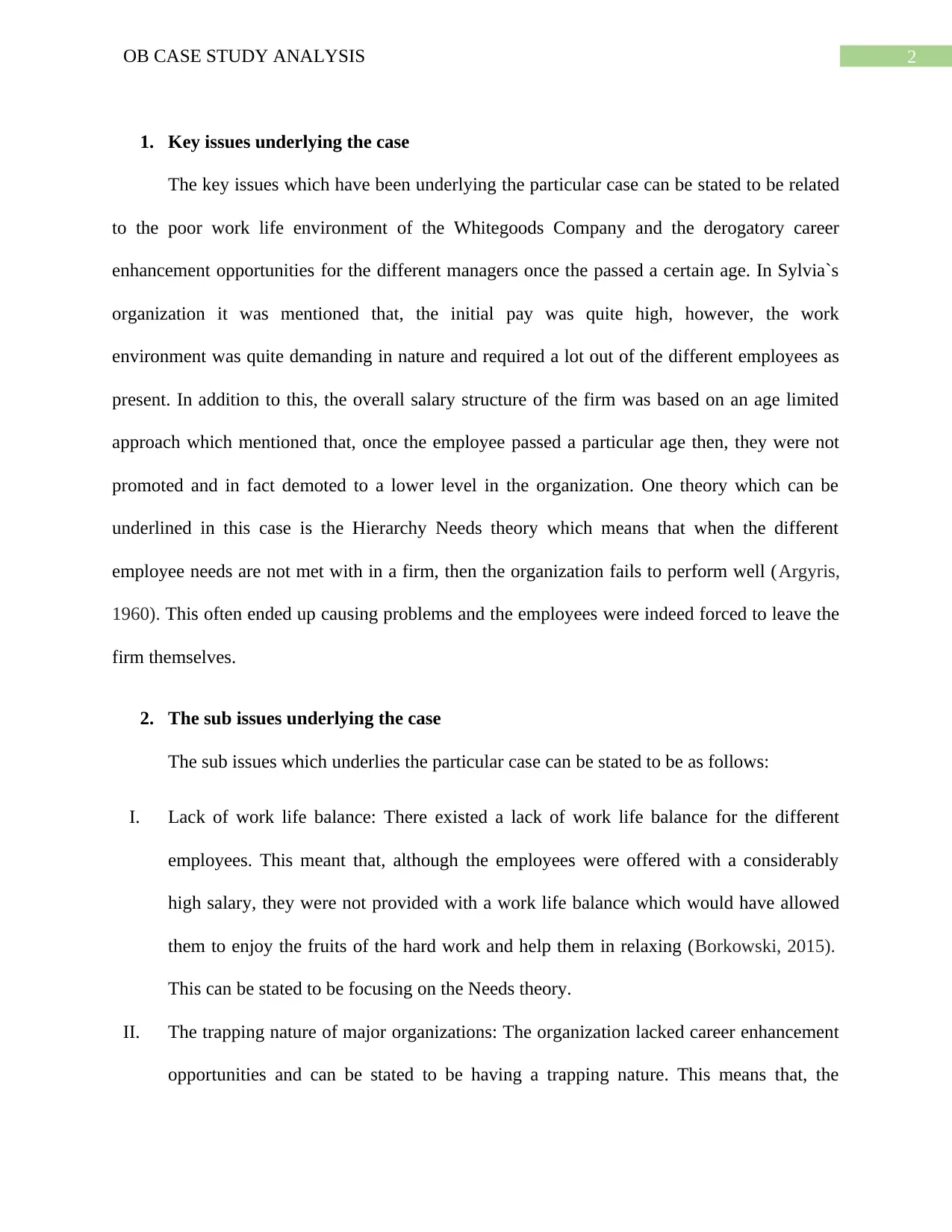
2OB CASE STUDY ANALYSIS
1. Key issues underlying the case
The key issues which have been underlying the particular case can be stated to be related
to the poor work life environment of the Whitegoods Company and the derogatory career
enhancement opportunities for the different managers once the passed a certain age. In Sylvia`s
organization it was mentioned that, the initial pay was quite high, however, the work
environment was quite demanding in nature and required a lot out of the different employees as
present. In addition to this, the overall salary structure of the firm was based on an age limited
approach which mentioned that, once the employee passed a particular age then, they were not
promoted and in fact demoted to a lower level in the organization. One theory which can be
underlined in this case is the Hierarchy Needs theory which means that when the different
employee needs are not met with in a firm, then the organization fails to perform well (Argyris,
1960). This often ended up causing problems and the employees were indeed forced to leave the
firm themselves.
2. The sub issues underlying the case
The sub issues which underlies the particular case can be stated to be as follows:
I. Lack of work life balance: There existed a lack of work life balance for the different
employees. This meant that, although the employees were offered with a considerably
high salary, they were not provided with a work life balance which would have allowed
them to enjoy the fruits of the hard work and help them in relaxing (Borkowski, 2015).
This can be stated to be focusing on the Needs theory.
II. The trapping nature of major organizations: The organization lacked career enhancement
opportunities and can be stated to be having a trapping nature. This means that, the
1. Key issues underlying the case
The key issues which have been underlying the particular case can be stated to be related
to the poor work life environment of the Whitegoods Company and the derogatory career
enhancement opportunities for the different managers once the passed a certain age. In Sylvia`s
organization it was mentioned that, the initial pay was quite high, however, the work
environment was quite demanding in nature and required a lot out of the different employees as
present. In addition to this, the overall salary structure of the firm was based on an age limited
approach which mentioned that, once the employee passed a particular age then, they were not
promoted and in fact demoted to a lower level in the organization. One theory which can be
underlined in this case is the Hierarchy Needs theory which means that when the different
employee needs are not met with in a firm, then the organization fails to perform well (Argyris,
1960). This often ended up causing problems and the employees were indeed forced to leave the
firm themselves.
2. The sub issues underlying the case
The sub issues which underlies the particular case can be stated to be as follows:
I. Lack of work life balance: There existed a lack of work life balance for the different
employees. This meant that, although the employees were offered with a considerably
high salary, they were not provided with a work life balance which would have allowed
them to enjoy the fruits of the hard work and help them in relaxing (Borkowski, 2015).
This can be stated to be focusing on the Needs theory.
II. The trapping nature of major organizations: The organization lacked career enhancement
opportunities and can be stated to be having a trapping nature. This means that, the
⊘ This is a preview!⊘
Do you want full access?
Subscribe today to unlock all pages.

Trusted by 1+ million students worldwide
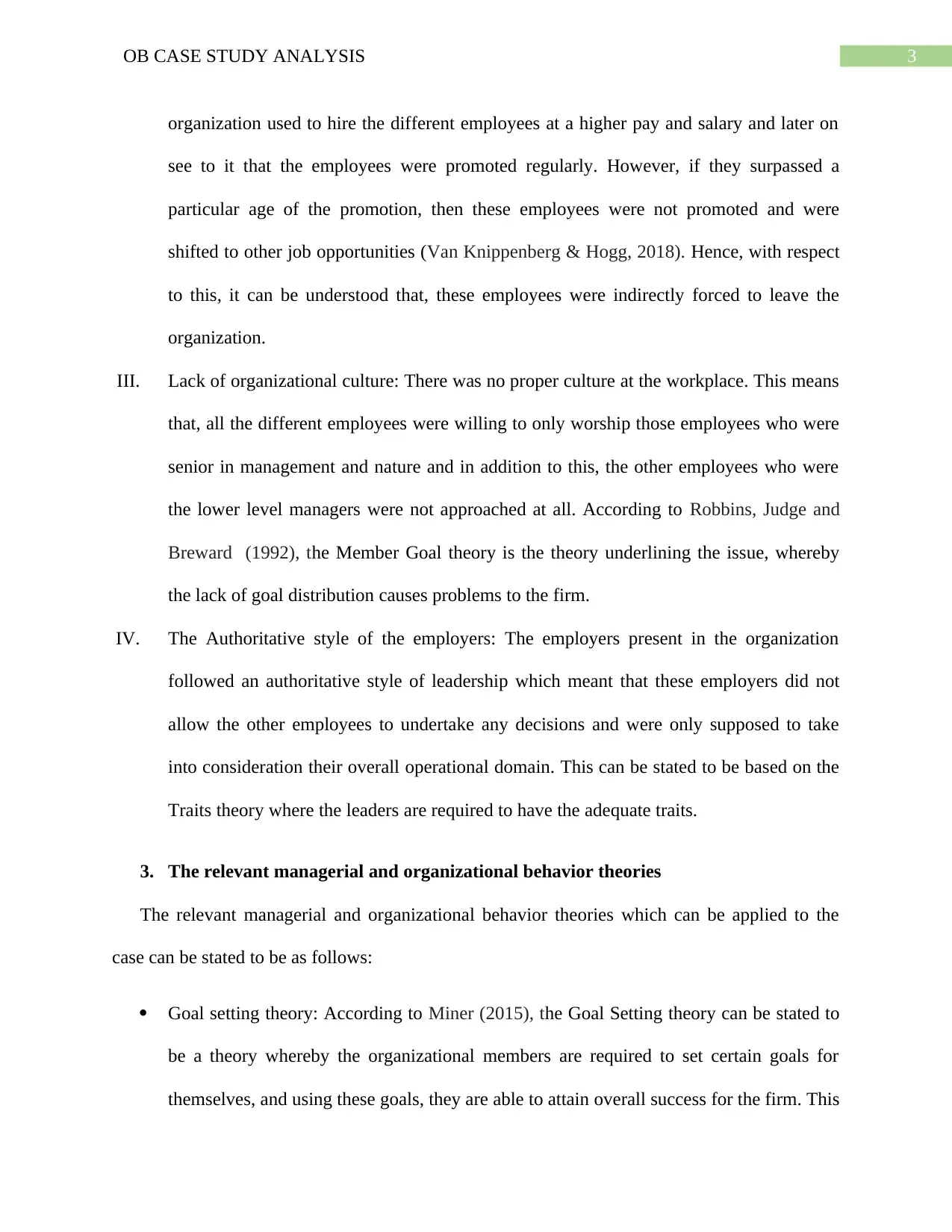
3OB CASE STUDY ANALYSIS
organization used to hire the different employees at a higher pay and salary and later on
see to it that the employees were promoted regularly. However, if they surpassed a
particular age of the promotion, then these employees were not promoted and were
shifted to other job opportunities (Van Knippenberg & Hogg, 2018). Hence, with respect
to this, it can be understood that, these employees were indirectly forced to leave the
organization.
III. Lack of organizational culture: There was no proper culture at the workplace. This means
that, all the different employees were willing to only worship those employees who were
senior in management and nature and in addition to this, the other employees who were
the lower level managers were not approached at all. According to Robbins, Judge and
Breward (1992), the Member Goal theory is the theory underlining the issue, whereby
the lack of goal distribution causes problems to the firm.
IV. The Authoritative style of the employers: The employers present in the organization
followed an authoritative style of leadership which meant that these employers did not
allow the other employees to undertake any decisions and were only supposed to take
into consideration their overall operational domain. This can be stated to be based on the
Traits theory where the leaders are required to have the adequate traits.
3. The relevant managerial and organizational behavior theories
The relevant managerial and organizational behavior theories which can be applied to the
case can be stated to be as follows:
Goal setting theory: According to Miner (2015), the Goal Setting theory can be stated to
be a theory whereby the organizational members are required to set certain goals for
themselves, and using these goals, they are able to attain overall success for the firm. This
organization used to hire the different employees at a higher pay and salary and later on
see to it that the employees were promoted regularly. However, if they surpassed a
particular age of the promotion, then these employees were not promoted and were
shifted to other job opportunities (Van Knippenberg & Hogg, 2018). Hence, with respect
to this, it can be understood that, these employees were indirectly forced to leave the
organization.
III. Lack of organizational culture: There was no proper culture at the workplace. This means
that, all the different employees were willing to only worship those employees who were
senior in management and nature and in addition to this, the other employees who were
the lower level managers were not approached at all. According to Robbins, Judge and
Breward (1992), the Member Goal theory is the theory underlining the issue, whereby
the lack of goal distribution causes problems to the firm.
IV. The Authoritative style of the employers: The employers present in the organization
followed an authoritative style of leadership which meant that these employers did not
allow the other employees to undertake any decisions and were only supposed to take
into consideration their overall operational domain. This can be stated to be based on the
Traits theory where the leaders are required to have the adequate traits.
3. The relevant managerial and organizational behavior theories
The relevant managerial and organizational behavior theories which can be applied to the
case can be stated to be as follows:
Goal setting theory: According to Miner (2015), the Goal Setting theory can be stated to
be a theory whereby the organizational members are required to set certain goals for
themselves, and using these goals, they are able to attain overall success for the firm. This
Paraphrase This Document
Need a fresh take? Get an instant paraphrase of this document with our AI Paraphraser
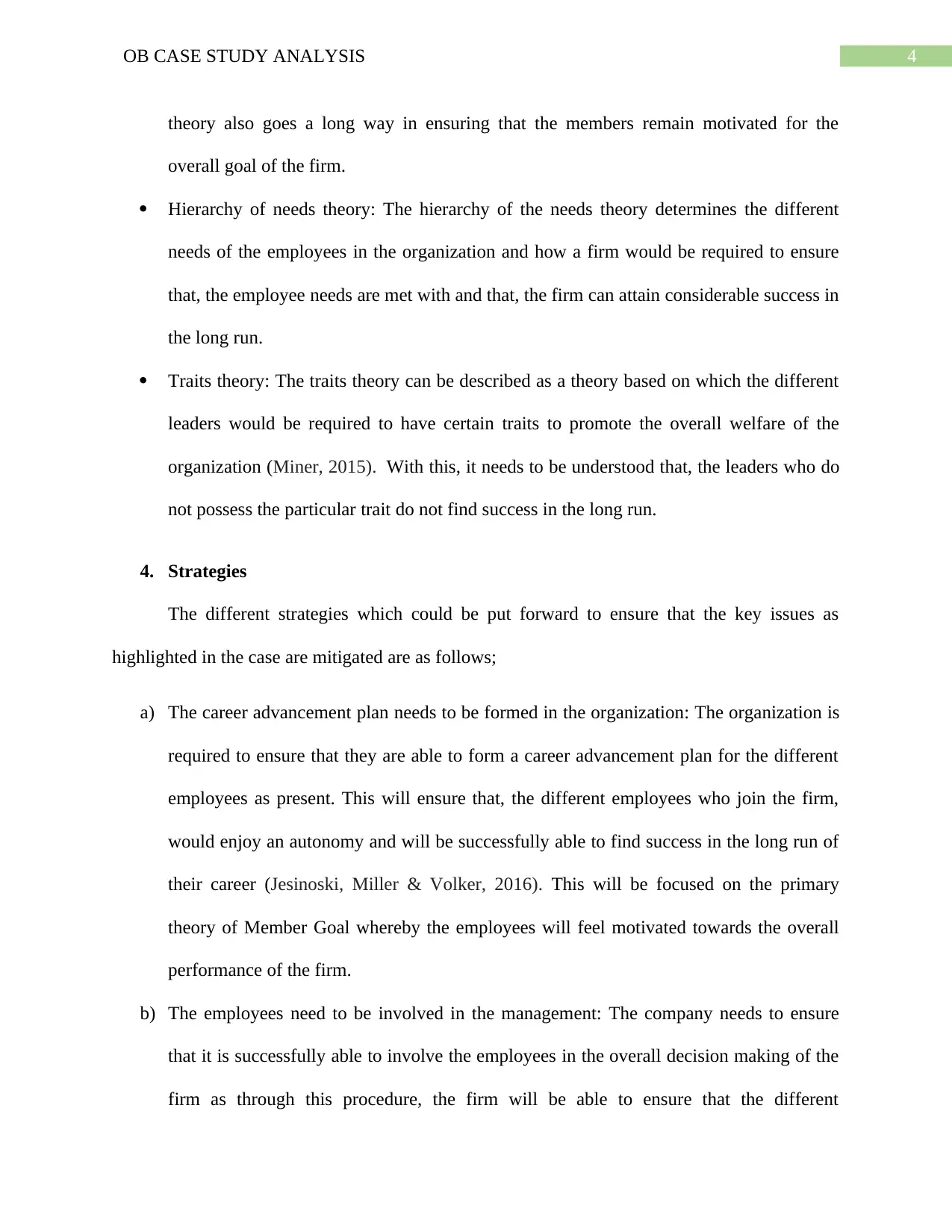
4OB CASE STUDY ANALYSIS
theory also goes a long way in ensuring that the members remain motivated for the
overall goal of the firm.
Hierarchy of needs theory: The hierarchy of the needs theory determines the different
needs of the employees in the organization and how a firm would be required to ensure
that, the employee needs are met with and that, the firm can attain considerable success in
the long run.
Traits theory: The traits theory can be described as a theory based on which the different
leaders would be required to have certain traits to promote the overall welfare of the
organization (Miner, 2015). With this, it needs to be understood that, the leaders who do
not possess the particular trait do not find success in the long run.
4. Strategies
The different strategies which could be put forward to ensure that the key issues as
highlighted in the case are mitigated are as follows;
a) The career advancement plan needs to be formed in the organization: The organization is
required to ensure that they are able to form a career advancement plan for the different
employees as present. This will ensure that, the different employees who join the firm,
would enjoy an autonomy and will be successfully able to find success in the long run of
their career (Jesinoski, Miller & Volker, 2016). This will be focused on the primary
theory of Member Goal whereby the employees will feel motivated towards the overall
performance of the firm.
b) The employees need to be involved in the management: The company needs to ensure
that it is successfully able to involve the employees in the overall decision making of the
firm as through this procedure, the firm will be able to ensure that the different
theory also goes a long way in ensuring that the members remain motivated for the
overall goal of the firm.
Hierarchy of needs theory: The hierarchy of the needs theory determines the different
needs of the employees in the organization and how a firm would be required to ensure
that, the employee needs are met with and that, the firm can attain considerable success in
the long run.
Traits theory: The traits theory can be described as a theory based on which the different
leaders would be required to have certain traits to promote the overall welfare of the
organization (Miner, 2015). With this, it needs to be understood that, the leaders who do
not possess the particular trait do not find success in the long run.
4. Strategies
The different strategies which could be put forward to ensure that the key issues as
highlighted in the case are mitigated are as follows;
a) The career advancement plan needs to be formed in the organization: The organization is
required to ensure that they are able to form a career advancement plan for the different
employees as present. This will ensure that, the different employees who join the firm,
would enjoy an autonomy and will be successfully able to find success in the long run of
their career (Jesinoski, Miller & Volker, 2016). This will be focused on the primary
theory of Member Goal whereby the employees will feel motivated towards the overall
performance of the firm.
b) The employees need to be involved in the management: The company needs to ensure
that it is successfully able to involve the employees in the overall decision making of the
firm as through this procedure, the firm will be able to ensure that the different
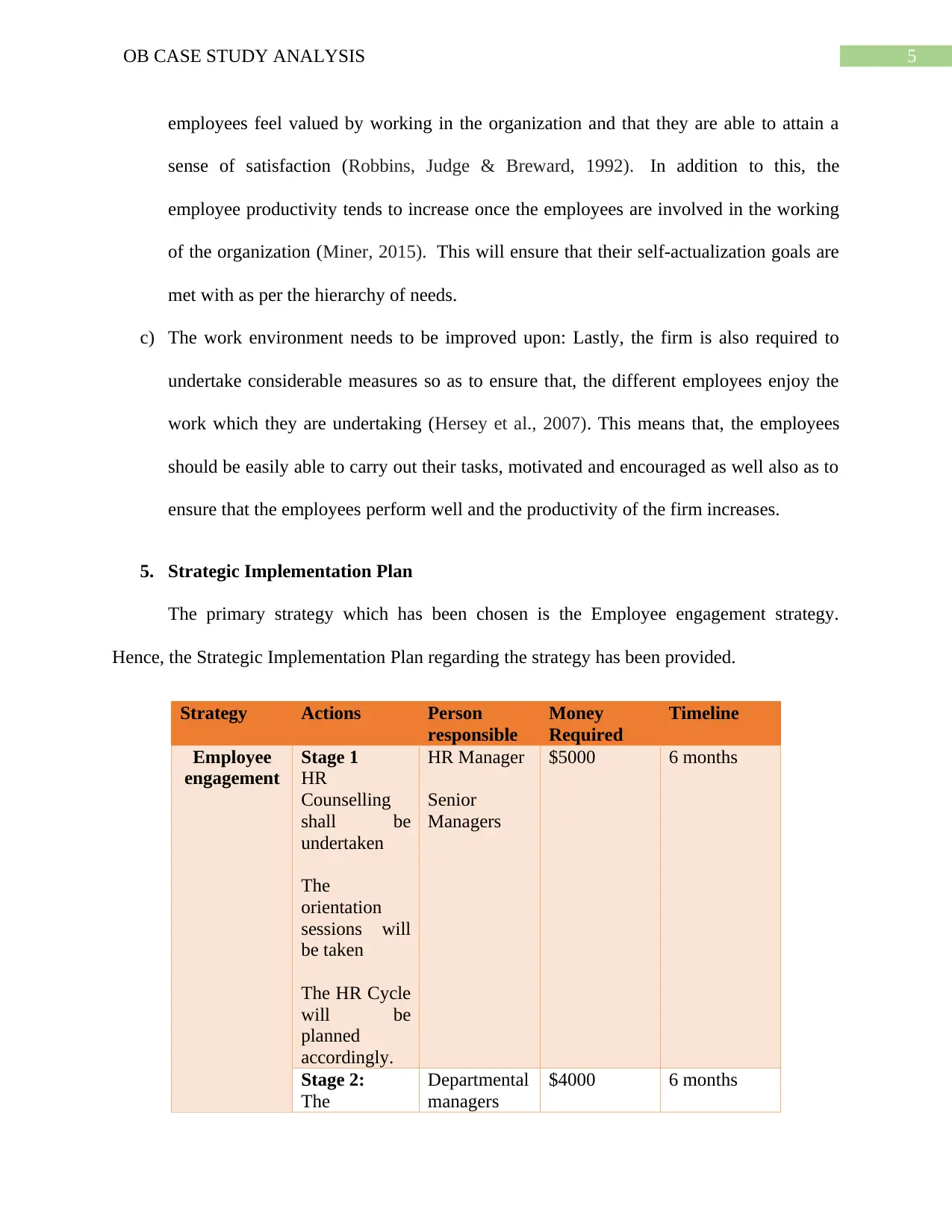
5OB CASE STUDY ANALYSIS
employees feel valued by working in the organization and that they are able to attain a
sense of satisfaction (Robbins, Judge & Breward, 1992). In addition to this, the
employee productivity tends to increase once the employees are involved in the working
of the organization (Miner, 2015). This will ensure that their self-actualization goals are
met with as per the hierarchy of needs.
c) The work environment needs to be improved upon: Lastly, the firm is also required to
undertake considerable measures so as to ensure that, the different employees enjoy the
work which they are undertaking (Hersey et al., 2007). This means that, the employees
should be easily able to carry out their tasks, motivated and encouraged as well also as to
ensure that the employees perform well and the productivity of the firm increases.
5. Strategic Implementation Plan
The primary strategy which has been chosen is the Employee engagement strategy.
Hence, the Strategic Implementation Plan regarding the strategy has been provided.
Strategy Actions Person
responsible
Money
Required
Timeline
Employee
engagement
Stage 1
HR
Counselling
shall be
undertaken
The
orientation
sessions will
be taken
The HR Cycle
will be
planned
accordingly.
HR Manager
Senior
Managers
$5000 6 months
Stage 2:
The
Departmental
managers
$4000 6 months
employees feel valued by working in the organization and that they are able to attain a
sense of satisfaction (Robbins, Judge & Breward, 1992). In addition to this, the
employee productivity tends to increase once the employees are involved in the working
of the organization (Miner, 2015). This will ensure that their self-actualization goals are
met with as per the hierarchy of needs.
c) The work environment needs to be improved upon: Lastly, the firm is also required to
undertake considerable measures so as to ensure that, the different employees enjoy the
work which they are undertaking (Hersey et al., 2007). This means that, the employees
should be easily able to carry out their tasks, motivated and encouraged as well also as to
ensure that the employees perform well and the productivity of the firm increases.
5. Strategic Implementation Plan
The primary strategy which has been chosen is the Employee engagement strategy.
Hence, the Strategic Implementation Plan regarding the strategy has been provided.
Strategy Actions Person
responsible
Money
Required
Timeline
Employee
engagement
Stage 1
HR
Counselling
shall be
undertaken
The
orientation
sessions will
be taken
The HR Cycle
will be
planned
accordingly.
HR Manager
Senior
Managers
$5000 6 months
Stage 2:
The
Departmental
managers
$4000 6 months
⊘ This is a preview!⊘
Do you want full access?
Subscribe today to unlock all pages.

Trusted by 1+ million students worldwide
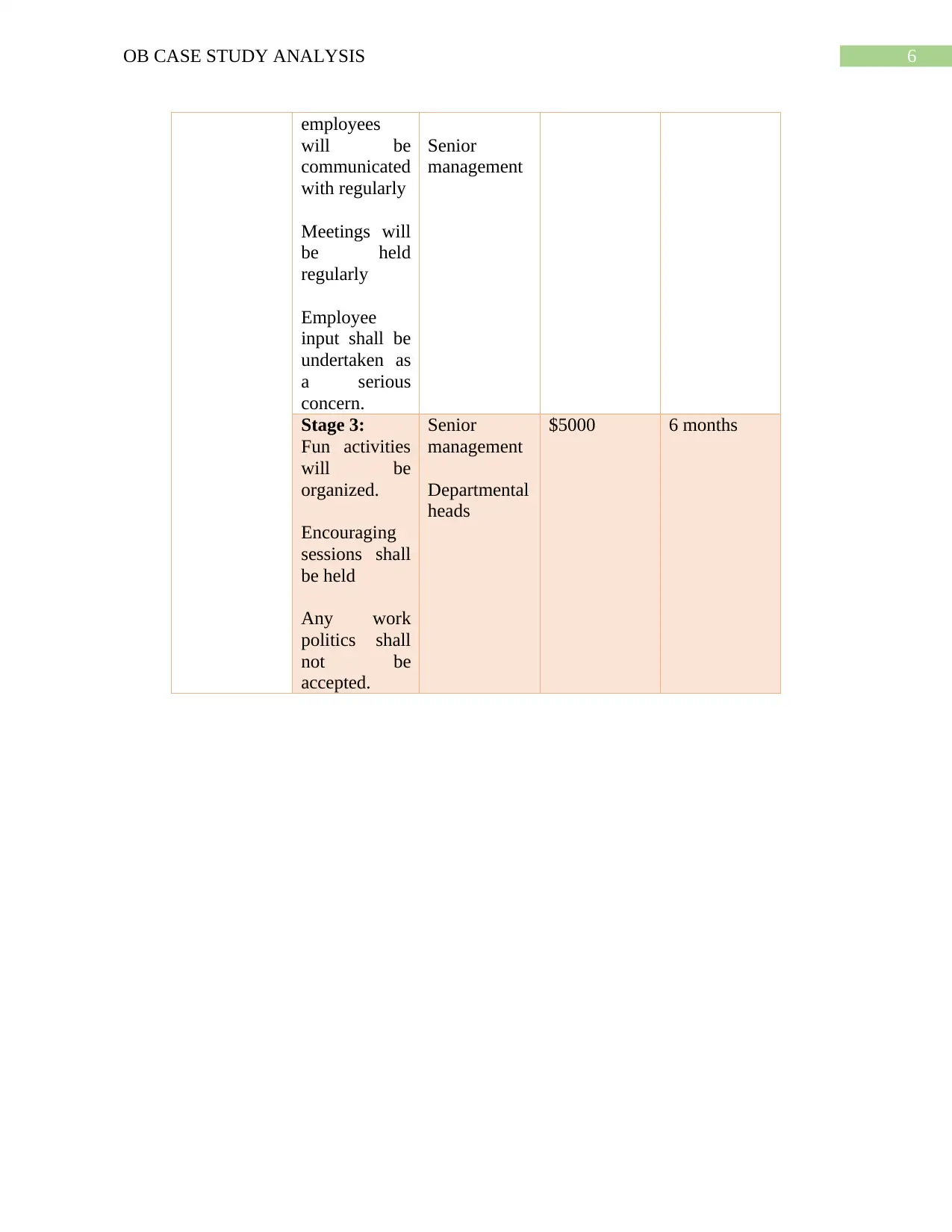
6OB CASE STUDY ANALYSIS
employees
will be
communicated
with regularly
Meetings will
be held
regularly
Employee
input shall be
undertaken as
a serious
concern.
Senior
management
Stage 3:
Fun activities
will be
organized.
Encouraging
sessions shall
be held
Any work
politics shall
not be
accepted.
Senior
management
Departmental
heads
$5000 6 months
employees
will be
communicated
with regularly
Meetings will
be held
regularly
Employee
input shall be
undertaken as
a serious
concern.
Senior
management
Stage 3:
Fun activities
will be
organized.
Encouraging
sessions shall
be held
Any work
politics shall
not be
accepted.
Senior
management
Departmental
heads
$5000 6 months
Paraphrase This Document
Need a fresh take? Get an instant paraphrase of this document with our AI Paraphraser
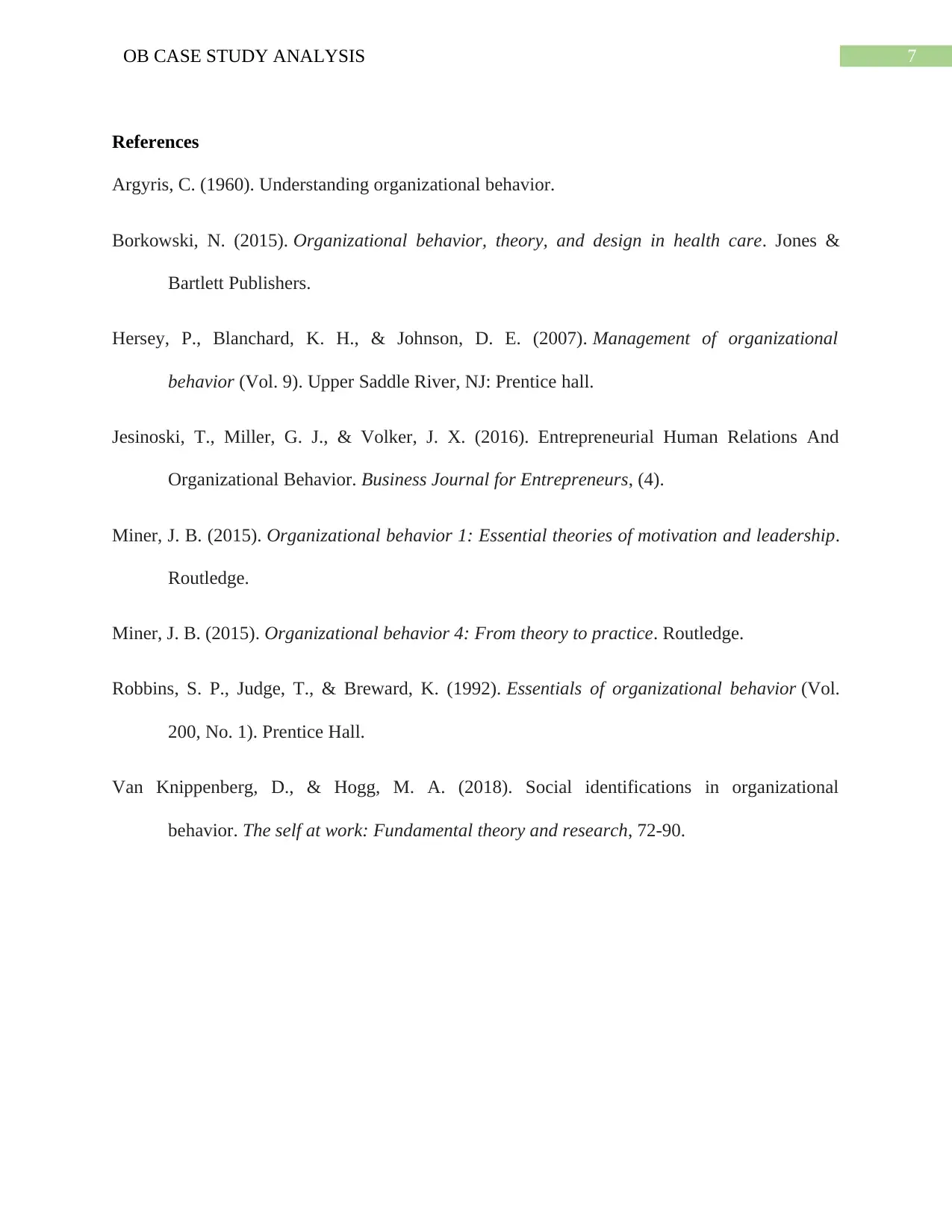
7OB CASE STUDY ANALYSIS
References
Argyris, C. (1960). Understanding organizational behavior.
Borkowski, N. (2015). Organizational behavior, theory, and design in health care. Jones &
Bartlett Publishers.
Hersey, P., Blanchard, K. H., & Johnson, D. E. (2007). Management of organizational
behavior (Vol. 9). Upper Saddle River, NJ: Prentice hall.
Jesinoski, T., Miller, G. J., & Volker, J. X. (2016). Entrepreneurial Human Relations And
Organizational Behavior. Business Journal for Entrepreneurs, (4).
Miner, J. B. (2015). Organizational behavior 1: Essential theories of motivation and leadership.
Routledge.
Miner, J. B. (2015). Organizational behavior 4: From theory to practice. Routledge.
Robbins, S. P., Judge, T., & Breward, K. (1992). Essentials of organizational behavior (Vol.
200, No. 1). Prentice Hall.
Van Knippenberg, D., & Hogg, M. A. (2018). Social identifications in organizational
behavior. The self at work: Fundamental theory and research, 72-90.
References
Argyris, C. (1960). Understanding organizational behavior.
Borkowski, N. (2015). Organizational behavior, theory, and design in health care. Jones &
Bartlett Publishers.
Hersey, P., Blanchard, K. H., & Johnson, D. E. (2007). Management of organizational
behavior (Vol. 9). Upper Saddle River, NJ: Prentice hall.
Jesinoski, T., Miller, G. J., & Volker, J. X. (2016). Entrepreneurial Human Relations And
Organizational Behavior. Business Journal for Entrepreneurs, (4).
Miner, J. B. (2015). Organizational behavior 1: Essential theories of motivation and leadership.
Routledge.
Miner, J. B. (2015). Organizational behavior 4: From theory to practice. Routledge.
Robbins, S. P., Judge, T., & Breward, K. (1992). Essentials of organizational behavior (Vol.
200, No. 1). Prentice Hall.
Van Knippenberg, D., & Hogg, M. A. (2018). Social identifications in organizational
behavior. The self at work: Fundamental theory and research, 72-90.
1 out of 8
Related Documents
Your All-in-One AI-Powered Toolkit for Academic Success.
+13062052269
info@desklib.com
Available 24*7 on WhatsApp / Email
![[object Object]](/_next/static/media/star-bottom.7253800d.svg)
Unlock your academic potential
Copyright © 2020–2025 A2Z Services. All Rights Reserved. Developed and managed by ZUCOL.




